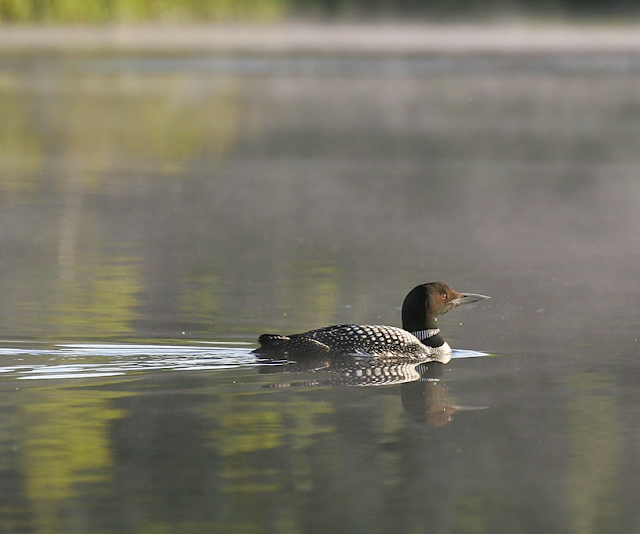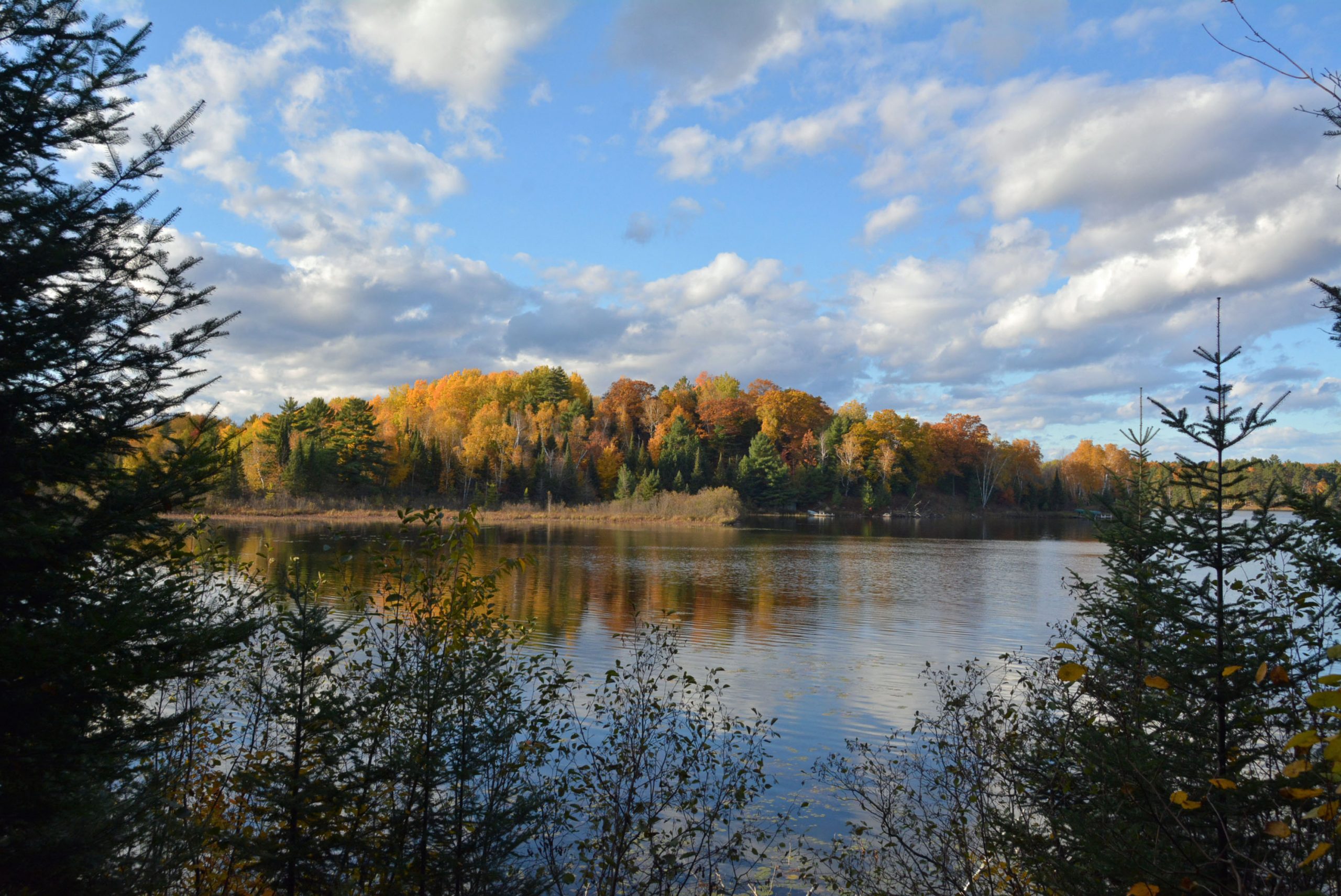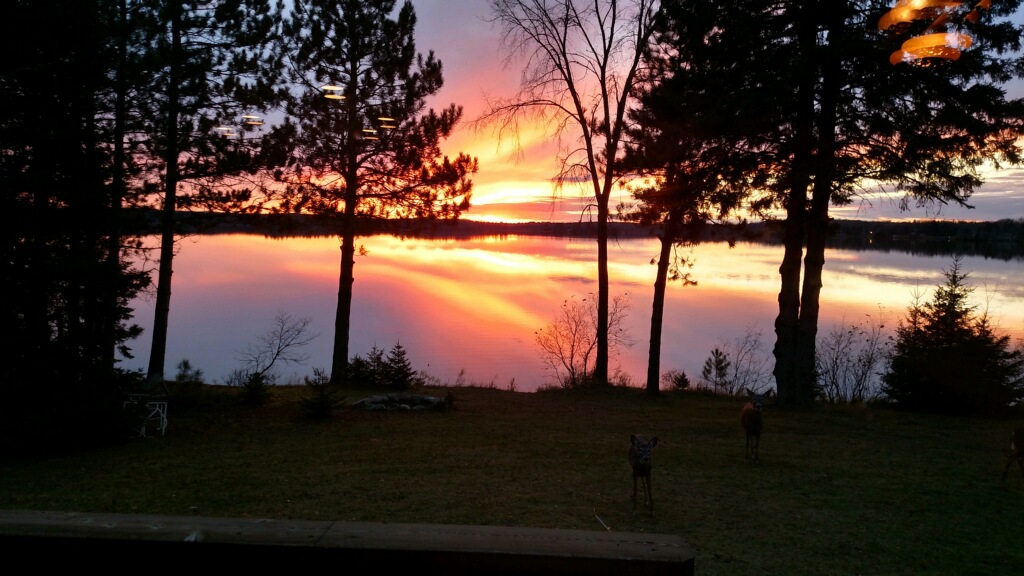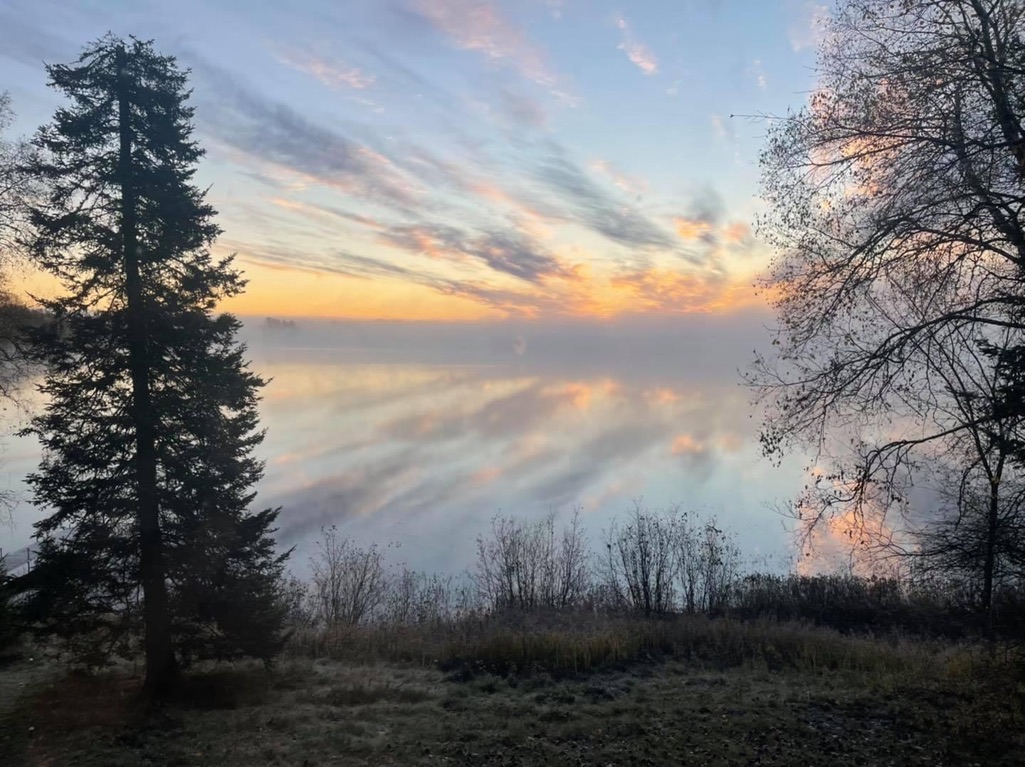The Quiet Lakes Improvement Association
Since its inception your QLIA has participated in what is now known as the Citizens Lake Monitoring Network (CLMN), a Wisconsin DNR sponsored system of water quality testing and data management. Once a month starting shortly after ice out volunteers visit six pre-established sites on the lake to perform testing. Water clarity is checked by lowering a Secchi disk and recording the maximum depth at which it is visible. Then a dissolved oxygen meter is used to record temperature and dissolved oxygen levels at one, three and five foot levels and at every five feet thereafter to the lake bottom. The collected data is then uploaded to a DNR site known as SWIMS (Surface Water Integrated Monitoring System). Learn more about the Wisconsin DNR CLMN program.
At two of the sites water is collected from the upper six-foot water column. Back on shore a measured amount intended for phosphorus testing is treated with acid (to destroy microorganisms which might alter phosphorus measurements) and another measured sample is drawn through a filter by use of a vacuum pump to collect chlorophyll. The water sample and filter are then packed in ice and mailed to the State Laboratory of Hygiene in Madison where they are tested and the results are forwarded to DNR.
Even a single days testing gives a snapshot of water quality conditions, but more significantly over time the data indicate trends in lake health. Both raw data and interpretative reports are available online.
Our two water quality experts, Michelle Keil and Carol Jarzyna provide water quality testing during the warmer months to keep our lakes in compliance with the Wisconsin DNR lake water quality program for Lost Land and Teal Lakes.
The Citizen Lake Monitoring Network, the core of the Wisconsin Lakes Partnership, creates a bond between over 1,000 citizen volunteers statewide and the DNR. Our goals are to collect high quality data, to educate and empower volunteers and to share this data and knowledge.
Our Lake volunteers measure water clarity, using the Secchi Disk method, as an indicator of water quality for Teal and Lost Land Lakes. Volunteers also collect chemistry, temperature and dissolved oxygen data, as well as monitor for the first appearance of aquatic invasive species near boat landings, other access points, or along the shoreline.
Here’s links to our water quality statistics for Lost Land, Team and Ghost Lakes for your review:
Ghost Lake Water Quality (through 2006)
Lost Land Lake Water Quality Information (through 2022)
Teal Lake Water Quality Information (through 2022)
Here’s some other reports for your review:
As a follow up to the 2024 herbicide treatment and to inform 2025 management activities, EWM bedmapping was performed in August 2024 by Endangered Resource Services. The following information is summarized from the 2024 Eurasian watermilfoil (Myriophyllum spicatum) Late Summer Bed Mapping Survey reports for Lost Land Lake and Teal Lake by Endangered Resource Services.
The sign with a cleaning brush and weed removal hook are available for your use. Anyone willing to help with the Clean Boats, Clean Waters, AIS education/prevention program should email us at [email protected]
Our lakes are blessed to have volunteers that spend countless hours controlling the EWM on our lakes. We have teams from both Teal and Lost Land Lakes that operate a mechanical harvester to pull the Eurasian Milfoil (EWM) from our lakes and dispose of it.
We received two Surface Water grants from the DNR that enabled the Association to get point-intercept maps of our lakes. Here’s the 2022 formal report to the Wisconsin DNR for both lakes:
2022 Final Report of Eurasian Water Milfoil (EWM) in Lost Land
2022 Final Report of Eurasian Water Milfoil (EWM) in Teal Lake

Photo Courtesy of Barb Ray
Black bears are commonly found in the northern third of Wisconsin, but are being sighted more frequently in the central and southern counties of Wisconsin as they expand their range. As the black bear population continues to grow, so do an increasing number of bear-human conflicts. In order for bears to coexist with humans, we have to understand normal bear behavior. Black bears tend to be shy, solitary animals, but at some times of the year, particularly in the spring when bears emerge from their winter dens and food is not abundant, bears may be on the lookout for opportunistic food sources. This might be your garbage can, or the bird feeder in your back yard. Nearly all human-bear conflicts are a result of the animals’ search for food. There are lots of simple things you can do to avoid conflicts with bears. With your help we can continue to live together with this great animal, enjoying their presence in the woods around us and at the same time reducing conflicts with bears around our homes and our campsites.
Black bears are attracted to numerous items around homes, including: bird feeders, compost piles, grills, pet food, gardens, and garbage. Here are some simple recommendations to avoid problem bears:
Contact the U.S. Dept. of Agriculture Wildlife Services. In the northern half of Wisconsin, call 1-800-228-1368, or in the southern half of Wisconsin call 1-800-433-0663. They can help you by providing additional information on reducing or eliminating your specific problem. If the situation is severe and presents a threat to health and human safety they can also remove the bear from the area.
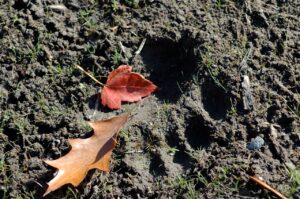
With a healthy black bear population, it is inevitable that black bears may damage agricultural crops in some areas. Particularly tasty treats are apiaries (beehives) and corn fields in the milk stage. Bears also occasionally attack livestock. The Wildlife Damage Abatement & Claims Program (WDACP) is available to help Wisconsin farmers whose crops or livestock are damaged by bears. If you would like more information on this program, please contact the Wildlife Damage Specialist at (608) 266-8204 or write us at
WI DNR, 101 S. Webster St. (WM/6)
P.O. Box 7921,
Madison, WI 53707-7921.
Weight: Males, 250-300 lbs; females, 120-280 lbs.
Body Characteristics: Bears appear bulky and are glossy black, with a tan patch across the nose. Brown and cinnamon colored bears appear less often.
Reproduction: Black bears are sexually mature at 3 years of age. Females will breed every other year from then on. Mating takes place from June to early July. During the 225-day gestation period, the fertilized egg experiences delayed implantation until late November or early December. Females then give birth to two to three cubs in January or early February while they are still in their winter sleep!
Cubs: At birth, the bear cubs weigh 7-12 oz. Their eyes are closed and fur is sparse. Growth takes place quickly. Cubs will first venture into the world with their mother in late March. They remain with their mother through the summer and usually den with her the following winter. In the springtime, the mother will chase off the cubs so she can breed again.
Diet: Bears are omnivorous, meaning they will eat almost anything! Their diet generally consists of vegetation, insects, berries, and nuts. Occasionally they eat carrion and small animals. They also target livestock, beehives, garbage, and agricultural crops.
Habitat: Large forested areas with swamps and stream bottoms, and areas with minimal development are good habitat for black bears They are also found around thick ground vegetation with lots of trees and bushes that produce nuts and berries. Fallen trees provide bears with locations to dig a winter den.
Behavior: Bears are typically shy and secretive animals; most go to great lengths to avoid humans. Bears typically wander over long distances. Home ranges are about 27 square miles for males, and about 8 square miles for females. Black bears are most active around dusk, but may be out and about any time of the day or night. Mid-May to late September is the period of most activity.
Winter Sleep: Bears are not true hibernators! During the winter months bears “den up” where they will fall into a deep sleep. During this time bears live off the body fat they have accumulated during the fall. Their body temperature, heartbeat, and respiration decrease, but not to the level where hibernation occurs. Dormant bears can be easily awakened from their winter sleep!
Information Courtesy of Wisconsin DNR Wildlife Education
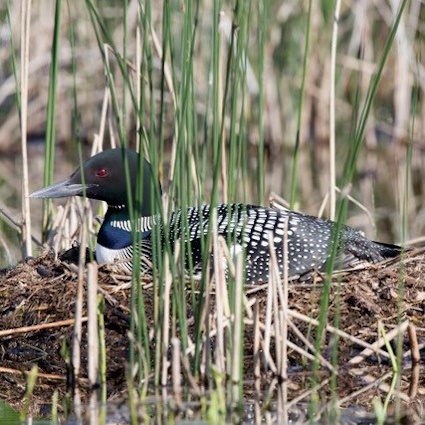
Listen. That eerie sound you hear is not a ghost haunting a northern lake. It’s the call of the common loon. This bird, whose ancestors roamed the earth 65 million years ago, can be found on Wisconsin’s northern lakes in the summer. They come here to breed and raise their young. Come fall, they head to the ocean coasts to overwinter. (You can track migrating loons as part of a loon migration study.)
Common items on the loon’s menu are perch, bullhead, and sunfish. They’re also known to eat frogs, crayfish, and even leeches—yum,yum. Check out the loon’s long, pointed beak—the better to grab fish and other goodies. The loon dives underwater to grab its prey and then swallows it in one gulp.
Loons are made for living on the water. The torpedo-like body is streamlined for swimming underwater. The legs of a loon are set far back on its body to work like oars with its large webbed feet. The body color, dark on top and light on the bottom makes loons less visible to fish as they swim. Some scientists think the loon’s red eyes help it see better underwater.
Because the loon’s legs are so far back on its body and because its body is so long, loons have trouble taking-off. Have you ever seen a loon “running” across a lake? A loon has to run across the water for up to ¼ mile beating its wings in order to get enough lift to take off. This need for a long runway means that loons need a certain size lake in order to take off. You’ll rarely find a loon in lakes under 9 or 10 acres.
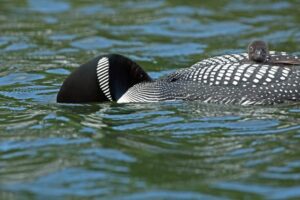
When disturbed the loon folds its wings against its body and swims upright in what is called a penguin dance. With its wings tucked against its body it looks kind of like a penguin. This dance is done when the loon is trying to scare enemies away from its chicks. “Dancing” like this takes a lot of energy so it’s important that you keep your distance from loons. If you get too close to it and its chicks or nest, the loon will think you’re its enemy and start the penguin dance. If you don’t leave the area, the loon can dance until it’s exhausted and dies.
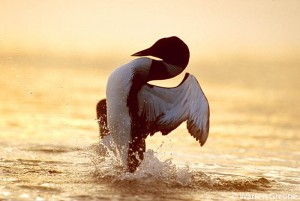
The loon has another dance that it does when it wants to chase away other birds. It splashes the water with its wings and kicks its feet so quickly that it is actually walking on water.
Loons are fast in the water but have trouble walking on land. They don’t spend much time on land, except to nest. Their nests are made of weeds and grass and are usually located in grass along the lake shoreline. A loon may use the same nest year after year. Two olive-brown eggs are laid. Crows, ravens, gulls, skunks, mink and raccoons (especially raccoons) eat the eggs. Both male and female loons take turns sitting on the eggs. The eggs hatch in about one month. Soon after the eggs hatch, the chicks are in the water swimming with their parents. Swimming in the cold water is hard on the chicks, so from time to time they hitch a ride on their parent’s back. This also protects them from predators like snapping turtles and muskies.
There are many Native American stories about loons. The Ojibwa (Chippewa) Indians called the loon “Mang” or “the most handsome of birds.” They thought the loons’ haunting cry was an omen of death. In some native legends the loon is a bird of magical powers, in others a messenger or a symbol of power. You can read some of these Native American stories in “Loon Book” by Tom Hollatz. Your public library should have a copy.
If you get a chance to visit the Quiet Lakes this summer, listen for the haunting call of the common loon.
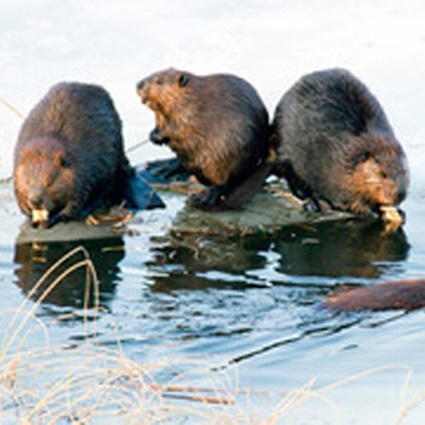
The Beaver is North America’s most common and largest rodent. Their most distinctive feature is their large flat tail, which serves as a rudder when swimming, a prop when sitting or standing upright, and it is a storehouse of fat for the winter. They are an aquatic mammal with large webbed hind feet ideal for swimming and hand-like front paws that allow them to manipulate objects easily. They have excellent senses of hearing and smell. When swimming under water a protective transparent membrane will cover their eyes and a flap closes to keep water out of their nostrils. They also have inner lips to keep water out when carrying sticks in their mouth. Beaver fur consists of short fine hair for warmth and longer hair for waterproofing.
Beavers are pure vegetarians, subsisting solely on woody and aquatic vegetation. They will eat fresh leaves, twigs, stems, and bark; preferring aspen, birch, cottonwood, maple, poplar and willow. Aquatic foodstuffs include cattails, water lilies, sedges and rushes.
Beavers build and maintain houses called lodges. The most recognized type is the dome shaped dwelling surrounded by water. It is made of sticks, mud and rock. Each lodge has a minimum of two chambers: one for sleeping, one for eating and grooming. They have at least two water filled tunnels leading from a chamber to the pond so the beaver can enter and exit the lodge underwater without being spotted by predators. Their babies, called kits, are born and nursed each spring. Beavers weigh 45 to 60 pounds. They mate at three years of age and they mate for life.
Beaver don’t hibernate, so they stock pile sticks under water. When the ponds freeze they remain in the lodge and leave only to retrieve sticks from the stock pile to eat.
The beaver’s ability to change the landscape is second only to humans. Thus the beaver has developed a bad reputation among some because they can cause roads to flood with their damming capabilities. But wetlands behind their dams lessen erosion, and act as a water purifier; creating a watery habitat for fish, turtles, frogs, birds and ducks. So the beaver’s ability to maintain the health of this ecosystem cannot be understated.
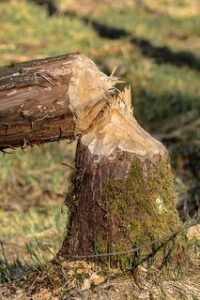

Poecile atricapillus, the Black-capped Chickadee, is a common neighbor at Long Lake. Although largely out of sight and relatively silent in summer, these birds are non-migratory, and with the fall of autumn leaves come flocking, the occasional “fee-bee” call of summer giving way to the familiar “Chicka-dee-dee-dee.”
If we listen carefully we can detect multiple calls, and the birds do use them for communication. The familiar Chicka-dee-dee can be an alarm call, with the number of “de’s” corresponding to the threat level. Other birds which tend to associate with Chickadee flocks do respond to their alarm calls, even when that species has no similar alarm call of its own. Other interesting facts concerning this tiny bird, according to the Cornell University Ornithology Lab, include:
Black oil sunflower seed is a favorite food, and they also enjoy suet. Cleanup of sunflower seed shells in the spring is a small price to pay for the joy of having them near the window all winter.
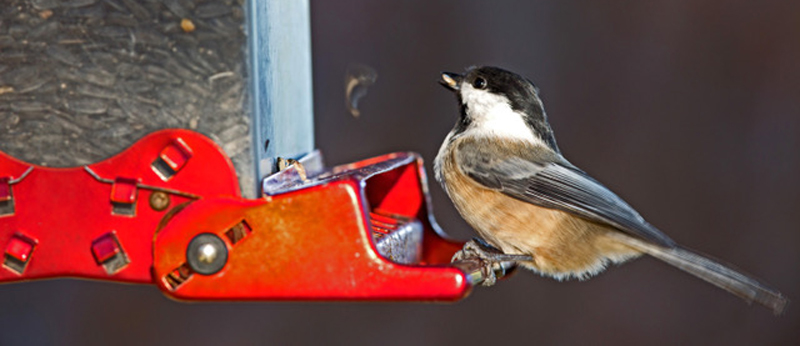

Of the 21 species of reptiles in Wisconsin, 11 are turtles. Here we will focus on the largest and heaviest, the common snapping turtle, Chelydra serpentine.
Like all turtles, the snapper is cold blooded, obtaining heat from the sun. Unlike the familiar painted turtle, snappers seldom crawl onto logs to sun themselves, but often float at the surface. They are almost entirely aquatic, with females coming to shore to lay eggs primarily in May and June. They will travel some distance to find a suitable egg laying site, having been found as far as a mile from water. Fortunately, the attempted housebreaking depicted in the side photo is not common behavior.
On land, snapping turtles can be quite aggressive. They should be handled only by those who truly know how. Lifting by the sides of the upper shell is dangerous, as they have a very long and mobile neck-the species name serpentine means “snake-like.” Their bite can easily sever a finger. Lifting by the tail could cause them permanent spinal damage. It is best to just watch them from a distance. In the water they are not a threat to humans, and when encountered they will swim away or hide in the muck or under vegetation.
Adult turtles have few predators, but the eggs are another matter. Nests are frequently raided by raccoon and skunks. Eggs that survive hatch in 80 to 90 days, although some overwinter in the nest. When a tiny turtle is seen heading for water in the spring, if is from an egg laid the prior year.
Snapping turtles are omnivorous, eating plants and just about any animal or fish they can catch, although their reputation as a duckling predator has been highly exaggerated. Younger turtles will forage for food, but the big ones hang motionless in the water, hunting by ambush.


One of the most fun-loving furry critters in Long Lake is the River Otter, sometimes fondly referred to as a ‘Stick Tail.’ We lake residents are very fortunate to have this mammal as one of our entertaining neighbors as otters are mainly located only in the northern portion of Wisconsin.
Not to be confused with the muskrat, who swims in a straight line displaying definite purpose, otters are very playful. According to the Wisconsin DNR they like to wrestle, chase other otters, and play capture and release with live prey. In winter they will take three or four bounding steps and then slide across the snow for 5-15 feet.
The otter’s diet is an aquatic mixture of fish, birds, and vegetation. After diving for food they resurface, float on their backs and use their tummy as a dining table. You will see them just laying there munching away on their delectable harvest.
For homes, otters use abandoned beaver lodges, hollowed out logs, or brush piles. The mama otter will give birth to two to four pups in April or May after a one year pregnancy. Babies are born about 4.5 inches long, furry, with their eyes closed for about a month. In eight to ten weeks, they are ready to hit the water. After turning one year of age, otters leave the family in search of a territory to call their own. Due to their voracious eating habits, an otter needs to claim a territory as large as three square miles.
Measurements: length: 2-4 feet; weight: 44-82 pounds; tail length: 1-1.5 feet
Life Expectancy: 10-15 years
Extra Tidbits: largest member of the weasel family; makes high-pitched scream when fighting or mating and will snort when confused or surprised; can dive to depths of more than 40 feet!
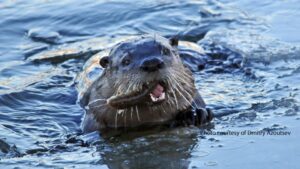
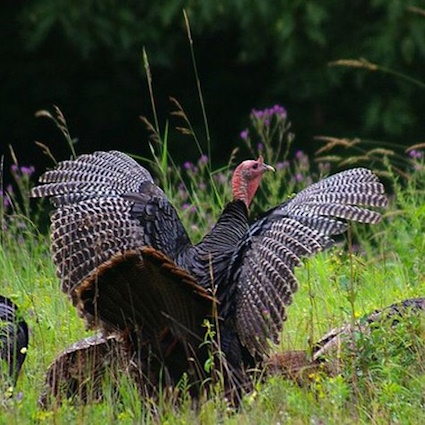
While once present in Wisconsin, wild turkeys completely disappeared due to loss of habitat during the lumbering era of the Nineteenth Century, the last known bird having been harvested in 1881. In 1976 Wisconsin traded ruffed grouse to Missouri in exchange for turkeys, releasing 29 birds in January of that year, with 334 more to follow. The reintroduction success has been phenomenal, with more than 45,000 birds being registered in the Spring 2016 hunting season alone.
The wild turkey is Wisconsin’s largest game bird, measuring 2.5 to 3 feet in height, with the male (gobbler) weighing in at 17 to 21 pounds and the hen at 8 to 11 pounds. Wingspans range from about 3 to 4.5 feet. Each bird has 5,000 to 6,000 feathers, which provide wintertime warmth, assistance in flight and which are sported in mating rituals.
Turkeys stay in flocks of 5 to 50 birds. The flock utilizes a home range of more than 1,000 acres. They prefer open grassy or grain field areas next to hardwood forests. The forest provides refuge from predators and a roosting place at night. Food consists of plants, insects, acorns, seeds and fruit.
Turkeys are wary, shy birds with excellent eyesight. They see in color, and have a 270 degree field of vision. They are capable of flying at over 55 miles per hour, but only for short distances. They prefer to run from predators, having a top speed of about 25 miles per hour.
While turkeys are North American birds, they originally derived their name, somewhat indirectly, from the nation of Turkey. They bear some resemblance to the guinea fowl of central Europe, sometimes called “turkey fowl” because originally imported there from Turkey. They are different birds, but somehow the name just stuck.
Had Benjamin Franklin had his way the turkey, not the bald eagle, would be our National Bird. Ben lost that argument.
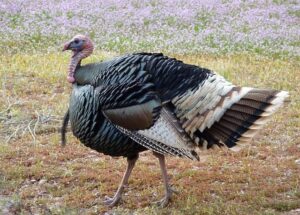

A Mudpuppy (common to Long Lake) is a large, aquatic salamander with a flat, square head, small eyes and distinctive a pair of feathery gills on either side of its head. The Mudpuppy name is thought to derive from either the external gills which are reminiscent of canine ears, or from the erroneous belief that they make vocalizations similar to those of a dog.
The smooth skin of the adult common mudpuppy can differ in coloration between red, black and grey-brown, with variable scattered blue-black spots across its back or occasionally faint stripes. The underside of the body is greyish and may also have dark spots. The juveniles have a highly distinctive pattern, with broad, dark stripes with yellow edges along the back.
The tail is short and flattened and the legs are short and slender, but well developed, with four toes on each foot. The size of an adult Mudpuppy is 8”-12” (20-30 cm) long.
Mating between the common mudpuppy occurs between autumn and winter and the female lays between 40 to 150 eggs. The female guards the eggs until they hatch.
The common mudpuppy relies mostly on its sense of smell to detect prey composed mainly of aquatic salamanders or small fish and their eggs.
The common mudpuppy is active all year, although it is most active from late autumn to spring. It is primarily nocturnal, but may sometimes emerge during the day in habitats where the water is cloudy.
An entirely aquatic species, the common mudpuppy inhabits freshwater ponds, lakes, streams, canals, reservoirs and rivers. It lives close to the bottom where there are rocks and logs for shelter. The range of the common mudpuppy extends south from eastern Canada to northern Georgia in the USA.
The common mudpuppy is sometimes caught by fishermen then discarded onto land due to the false belief that it is poisonous or detrimental to the game fish population, which it is not.
The water use restrictions associated with use of ProcellaCOR EC are noted below:
For additional information on the proposed treatment, please click on one of the links below to find a copy of the following documents:
If you choose to go to Schmidt’s Aquatic website, once on the home page, click on the “links tab” then click on Teal, Lost Land and Ghost Lakes Improvement Association Tab. at WWW.SCHMIDTSAQUATIC.COM
For questions about the project, please contact us. [email protected]
Lost Land Lake EWM – 21 beds of EWM totaling 263.34 acres
Teal Lake EWM – 35 beds of EWM totaling 44.45 acres
The amount of EWM (Eurasian Milfoil) in Lost Land Lake is more than 20% of the lake and is concentrated near the shoreline. Our consultant is identifying options for how we can effectively decrease the amount of AIS in Lost Land and Teal lakes. Stay tuned for more information as we head into early 2023 and we update our Aquatic Plant Management (APM) plan with the DNR and get all the data from the point intercept study recently completed on Teal, Lost Land and Ghost Lakes
Our water quality analyst, Michele Keil, has recently completed a visual evaluation of Ghost Lake, and did not see any evidence of AIS.
2023 Annual Meeting:
We had over 70 people attend the QLIA Annual Meeting. Some highlights included an update on aquatic invasive species (AIS) in our lakes and also other important information regarding fundraising to support our lake management needs moving forward. Please see the minutes to this meeting for your review
2023 Annual Picnic:
We had over 60 people attend the annual QLIA picnic! The QLIA Board partnered with Red Deer Resort to host a wonderful cook-out with all the trimmings! There was the annual corn-hole tournament, 50/50 raffle, pie auction and an update from our lake consultant. Here’s the summary of his report as he works to complete the Surface Water Grants during 2023 that we received from the DNR for Teal, Lost Land and Ghost Lakes.
2022 Dam Safety Inspection Report
The QLIA was required to have the Teal River Flowage dam inspected per the US Forestry Service after a tree fell on it. This dam will need to be inspected every two years, and it is an important part of maintaining our lake water levels. See this link for the 2022 Inspection Report
Association Dues & Why they Are Important!
We need all residents around our lakes to join and renew their Lake Association membership which was formed to manage our lakes and the annual dues ($30) fund important projects to protect our lakes:
Here’s the Association form to join or renew your membership
Please mail to:
Quiet Lakes Association
P.O. Box 214
Hayward WI 54843
If you have questions or want to discuss any issues relating to our lakes please contact us HERE.
Boat Speeding
Recently in late Summer 2022 issue of the Sawyer County Record newspaper, it was reported that the Sawyer County Sheriff ticketed a speeding boat in the thoroughfare with a $200+ fine. According to several sources, the Deputy wrote a formal enforcement ticket and several warnings. Please be mindful of the 10 MPH speed limit on our lakes as the Sheriff will be visiting from time to time.
Oak Wilt Found In Town of Spider Lake
Oak Wilt is the most deadly disease facing oaks in Wisconsin today. Caused by a fungus, it almost always kills infected trees. Dead oaks can create hazards, reduce property values and aesthetics, and reduce wildlife habitat and water quality.
First detected in Sawyer County in 2012, Oak Wilt cases have increased significantly since 2016, including confirmed cases in the Town of Spider Lake . Email: Paul Cigan, Wisconsin DNR Forest Health Specialist for the Northwest region for more information on Oak Wilt diagnosis, prevention, and control – Phone: 715-416-4920
Please see this LINK for more Oak Wilt information.
The Quiet Lakes Improvement Association needs volunteers to work on several committees: Aquatic Invasive Species Control, Fisheries Management, Fundraising and Welcome Committee.
EWM (Eurasian Milfoil) Control: Our lake volunteers use a mechanical harvester to pull mil-foil on our lakes. Below is a video of the harvester working on Lost Land Lake. If you are interested in helping volunteer on our harvester team, please email us
